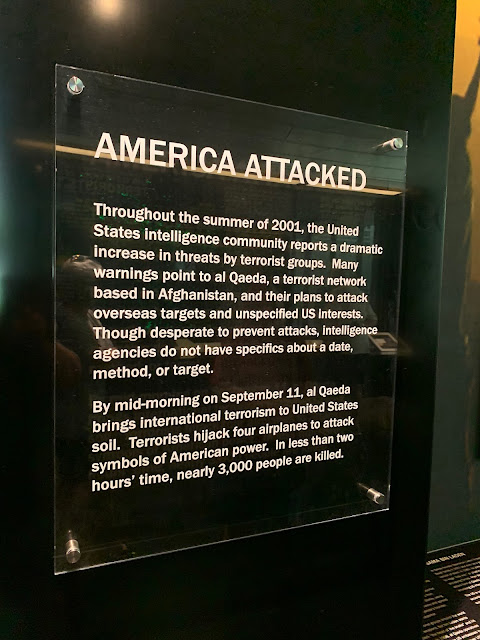As we continued our journey we drove to an RV site near the Flight 93 Memorial in Shanksville, Pennsylvania. The park is in the middle of cornfields and was quite an ordeal to get there.
We're in Amish country now
We drove about half an hour to the little town of Stoystown, Pennsylvania with a population in 2020 of 300. Tiny.
And then we were there.
We parked the truck and started walking towards an overlook.
And there it was in front of us - the crash site designated by the big rock on the edge of the field. See it?
The exhibit followed a timeline of the events of the day. I'm sure we all remember where we were that day and the horror that unfolded as we watched the news.
While two planes crashed into the World Trade Center and one into the Pentagon, there was a fourth plane that was on its way from Newark, New Jersey to San Francisco.
And then, that fourth plane became the focus.
Thirteen passengers and crew members placed calls to the authorities, to United Airlines, and to their family members and friends. According to the FBI, thirty-seven phone calls were placed from on board Flight 93 from 9:28 when the plane was hijacked until the time of the crash at 10:03. Thirty-five of these calls were made on the Airfones located on the back of the seats in the last nine rows of the plane. Credit card records reveal the time of the call, Airfone caller's name, the number or numbers dialed, the duration of the call, and the row from which the call was placed. These phone records were entered as evidence during the sentencing trial of Zacarias Moussaoui in 2006. According to the 9/11 Commission Report, the series of calls from the flight provided vital information both to the ground and to the passengers.
It's hard to see the detail but the seating chart is below.
Blue is crew, gray is terrorist, yellow is passenger, no color is vacant.
The most moving and emotional part of the exhibit for me was the recordings of the passengers and crew who called their loved ones to tell them they weren't sure they would make it, say goodbye, etc. They have it set up so you can use headphones and hear those recordings.
The most gut wrenching call for me to listen to the woman who called her sister. As she left her message, she told her sister where the important things were in her house and gave her the combination for her safe.
And then it happened.
Investigators to the crash of Flight 93 searched diligently for the plane's "black boxes", the flight data recorder (FDR) and cockpit voice recorder (CVR). Flight 93's FDR was found on September 13, 2001 - it was uncovered in the impact crater, 15 feet underground.
There was a beautiful wall displaying the photos of every passenger and crew member aboard the flight including some of their personal effects.
The National Transportation Safety Board (NTSB) used data from Flight's 93's FDR to determine the flight path, altitude, and control inputs from the cockpit. This information helped investigators to recreate the last flight of United Airlines Flight 93.
My heart was heavy as we moved outside. And it was then that we realized the walkway we used to come to the Visitor Center had a meaning and was put in a specific place. It was a recreation of the flight path, complete with the time engraved in the path as it passed overhead.
The monument is beautiful.
After we left the memorial, we drove about 20 minutes to Johnstown, the site of a massive flood in 1889. Years ago Ron read the book by David McCullough who, coincidentally, had died just a few days before we visited and found it fascinating.
The movie explaining the flood was very well done and gave a complete synopsis of the flood. A few other items struck me.
A photo of the devastation
It's nearly impossible to see the detail in a photo but on the left side it lists the name of the accident victim, the date, and the treatment receives. Almost at the bottom of that side it says "Great Disaster Occurred" and continued on the next page is the name, the date, and the treatment was "burial". And this was just at one facility.
If you're interested in reading Pulitzer-prize winning author David McCullough's book (he also wrote John Adams and Truman, to name a few) you can find it wherever you buy books.
RIP, David McCullough.







































This definitely sounds like a place to visit. And I had relatives who died in the Johnstown flood...
ReplyDeleteThere you go - a road trip! I can't describe how moving the memorial is.
Delete